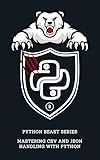Best JSON Conversion Tools to Buy in December 2025
To convert nested JSON to a pandas dataframe, you can use the json_normalize function from the pandas library. This function allows you to flatten nested JSON data into a tabular format that can be easily manipulated using pandas. Simply pass the nested JSON data as an argument to json_normalize and it will automatically convert it into a dataframe. You can then perform various operations on the dataframe such as filtering, sorting, and aggregating the data. This makes it much easier to work with nested JSON data in a structured and organized manner.
How to import nested JSON file and convert it to pandas dataframe?
To import a nested JSON file and convert it to a pandas dataframe, you can follow these steps:
- Import the necessary libraries:
import pandas as pd import json
- Load the JSON file into a Python object:
with open('nested_json_file.json') as f: data = json.load(f)
- Flatten the nested JSON object:
def flatten_json(nested_json): out = {}
def flatten(x, name=''):
if type(x) is dict:
for a in x:
flatten(x\[a\], name + a + '\_')
elif type(x) is list:
i = 0
for a in x:
flatten(a, name + str(i) + '\_')
i += 1
else:
out\[name\[:-1\]\] = x
flatten(nested\_json)
return out
flat_data = [flatten_json(item) for item in data]
- Create a pandas dataframe from the flattened data:
df = pd.DataFrame(flat_data)
Now the df dataframe contains the flattened JSON data in a format that is suitable for data analysis using pandas.
What is the easiest way to convert deeply nested JSON to pandas dataframe?
The easiest way to convert deeply nested JSON to a pandas DataFrame is to use the json_normalize function from the pandas library. This function helps to normalize semi-structured JSON into a flat table.
Here is an example code snippet that demonstrates how to convert deeply nested JSON to a pandas DataFrame:
import pandas as pd from pandas.io.json import json_normalize
Sample nested JSON data
data = { "name": "John", "age": 30, "address": { "street": "123 Main St", "city": "New York", "zip": "10001" }, "contact": { "email": "john@example.com", "phone": "555-1234" } }
Convert nested JSON to pandas DataFrame
df = json_normalize(data)
Display the DataFrame
print(df)
This code snippet will convert the nested JSON data into a pandas DataFrame with the appropriate columns and values. You can modify the data variable with your nested JSON data to convert it to a DataFrame in a similar manner.
How to work with nested JSON structure and convert it to a pandas dataframe?
To work with nested JSON structures and convert it to a pandas dataframe, you can follow these steps:
- Load the JSON data into a Python dictionary using the json module:
import json
with open('data.json') as f: data = json.load(f)
- Flatten the nested JSON structure using the json_normalize function from the pandas library:
from pandas.io.json import json_normalize
df = json_normalize(data)
- Optionally, you can specify the record path and meta parameter to flatten specific nested structures within the JSON data:
df = json_normalize(data, record_path=['path.to.nested.structure'], meta=['other.nested.structure'])
- Now you have a pandas dataframe representing the flattened JSON data, which you can manipulate, analyze, and visualize as needed.
By following these steps, you can easily work with nested JSON structures and convert them into a pandas dataframe for further analysis and processing.
How to structure a nested JSON file for easy conversion to pandas dataframe?
To structure a nested JSON file for easy conversion to a pandas DataFrame, you should organize the data in a hierarchical way. Here's an example of how you can structure a nested JSON file:
{ "data": [ { "id": 1, "name": "John", "age": 25, "address": { "street": "123 Main Street", "city": "New York", "zipcode": "10001" }, "contacts": [ { "type": "email", "value": "john@example.com" }, { "type": "phone", "value": "555-1234" } ] }, { "id": 2, "name": "Jane", "age": 30, "address": { "street": "456 Elm Street", "city": "San Francisco", "zipcode": "94105" }, "contacts": [ { "type": "email", "value": "jane@example.com" }, { "type": "phone", "value": "555-5678" } ] } ] }
In this example, the JSON file contains a list of objects (or records) under the "data" key. Each object represents an individual with attributes like "id", "name", "age", "address", and "contacts". The "address" and "contacts" attributes are nested objects within each individual's record.
To convert this nested JSON file to a pandas DataFrame, you can use the pd.DataFrame() constructor provided by the pandas library. Here's an example code snippet to convert the JSON file to a DataFrame:
import pandas as pd import json
Load the JSON file
with open('nested_data.json') as f: data = json.load(f)
Create a DataFrame from the JSON data
df = pd.DataFrame(data['data'])
Display the DataFrame
print(df)
By following this structure and using the pd.DataFrame() constructor, you can easily convert a nested JSON file into a pandas DataFrame for data analysis and manipulation.
How to convert JSON file with nested data to pandas dataframe?
You can convert a JSON file with nested data to a pandas DataFrame using the json and pandas libraries in Python. Here's an example:
import json import pandas as pd
Load the JSON file
with open('data.json') as f: data = json.load(f)
Convert nested JSON data to flat JSON data
flat_data = []
def flatten_json(json_data, prefix=''): if isinstance(json_data, dict): for key, value in json_data.items(): flatten_json(value, prefix + key + '_') elif isinstance(json_data, list): for i, item in enumerate(json_data): flatten_json(item, prefix + str(i) + '_') else: flat_data.append({prefix[:-1]: json_data})
flatten_json(data)
Convert flat JSON data to pandas DataFrame
df = pd.DataFrame(flat_data)
print(df)
This code snippet will load the JSON data from the file 'data.json', flatten the nested JSON data, and then convert the flat JSON data to a pandas DataFrame. You can then manipulate, analyze, and visualize the data using pandas DataFrame functions.
What is the optimal method to convert complex nested JSON to pandas dataframe?
The optimal method to convert complex nested JSON to a pandas dataframe is to use the pd.json_normalize() function. This function can handle complex nested JSON structures and flatten them into a tabular format suitable for a pandas dataframe.
Here's an example of how you can use pd.json_normalize() to convert a complex nested JSON into a pandas dataframe:
import pandas as pd import json
Load your JSON data
with open('data.json') as f: data = json.load(f)
Flatten the nested JSON data into a pandas dataframe
df = pd.json_normalize(data)
Display the dataframe
print(df)
By using pd.json_normalize(), you can easily convert complex nested JSON structures into a pandas dataframe and work with the data efficiently.



